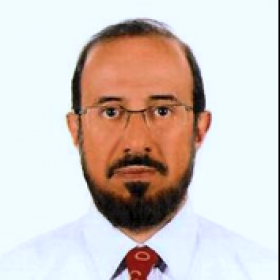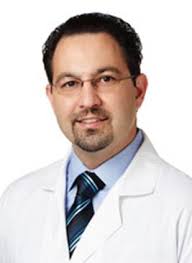Day 1 :
Keynote Forum
Amr Amin
Professor in Molecular Biology, UAE University, UAE
Keynote: Novel natural product may be a new hope in the fi ght against liver cancer

Biography:
Amr Amin has completed his PhD at University of Illinois at Chicago, and received a Post-doctoral
training in the fi eld of Molecular Genetics at University of Pennsylvania School of Medicine. He
started his academic career at UAE University, where he serves now as a Professor of Cell and
molecular Biology. His research focuses on ways to control cancer, particularly liver cancer. He
has published many research articles, reviews, and serves as Ad Hoc reviewer and as an Editorial
member of many specialized peer-reviewed journals. He is also a member of many specialized
societies and the sole recipient of multiple national and international scientifi c awards.
Abstract:
Th e multikinase inhibitor, sorafenib, remains for a decade now the fi rst and
only systemic therapy for the treatment of hepatocellular carcinoma (HCC).
Th us, a novel approach against HCC is essential for a better therapeutic
outcome. Th e aim of this study is to assess the chemopreventive action of
Saff ron’s main biomolecules against chemically-induced liver cancer in rats,
and to explore the mechanisms by which Saff ron’s biomolecules employ
their anti-tumor eff ects. We provide a network analysis of diff erentially
expressed genes in tissues of animals pre-treated with Saff ron’s biomolecules
in comparison to induced-HCC animal's tissue. To further support our
results, we assessed the in vitro eff ects of those natural products on cells
viability and cell cycle distribution. Network analysis was also conducted
and identifi ed NF-kB as a potential regulatory hub, and therefore, a
candidate therapeutic drug target.

Biography:
Dimitar Tonev was trained as an Internal Disease Specialist in Sofi a Medical Academy with two
subsequent specializations in Gastroenterology/Hepatology and Pharmaceutical Medicine. He is
trilingual with 11 years of experience in Clinical Practice and 20 years of Clinical development and
medical affairs. During this time, he served as a Medical monitor for a variety of clinical trials in
motility and acid related disorders; HCV-PACIFIC, STEPS in G3, PRINCIPAL; HBV ENTEBE trial
as well as studies in pandemic infl uenza and HIV co-infection. In the last four years he has created
ICPT Medical organization across EU, Canada and Australasia and contributed to pivotal trials in
NASH, PBC, PSC and biliary acid diarrhea. He has been an invited Speaker at National (BASL,
BVHG) and International level (Global NASH Conference). He joined IQVIA as Medical Strategy
Lead for liver diseases and is responsible for building our internal capabilities related to NASH
in Europe. He is also a Chief investigator for the NASH cost-effectiveness study Radical1 in the
UK and has an Operational oversight of more than 20 commercial NASH studies via diagnostic
vendors he is consulting.
Abstract:
Nonalcoholic fatty liver disease (NAFLD) is becoming the leading cause of liver
disease worldwide, and the prevalence is still increasing, potentially becoming a
leading cause of liver transplantation in the developed world. NAFLD is defi ned
in the presence of increased hepatic fat content not explained by at risk alcohol
intake, and is epidemiologically associated with obesity, insulin resistance and
metabolic disorders. It covers a broad histological spectrum ranging from
simple uncomplicated steatosis, to nonalcoholic steatohepatitis (NASH), which
is characterized by hepatocellular damage and infl ammation and may progress
to advanced liver disease and hepatocellular carcinoma. Th e pathogenesis of
NASH is multifactorial and badly understood and stratifi ed, but an important
role is likely played by infl ammation triggered by predisposing genetic factors,
oxidative stress, and bacterial products derived from the gut. Recent data seem
to suggest that hepatic lipid accumulation itself may also be involved in NASH by
inducing lipotoxicity and driving secondary infl ammation, leading to activation
of fi brogenesis. Although lifestyle modifi cation, weight loss and increased physical
activity are eff ective in improving liver histology in patients with NASH, these
goals are only achieved in a minority of patients. Unfortunately, pharmacological
treatments for this condition are not yet registered and we have seen multiple,
largely a negative results from the initial wave of predominantly academic research
cohorts. Pharmaceutical companies’ eff orts in this fi eld have been reinvigorated
aft er the publication of the successful NIDDK study FLINT. Multiple drug classes
under development either tackle hepatic fat accumulation or act downstream by
modulating infl ammation and fi brogenesis. Among drugs that infl uence hepatic
lipid metabolism, particularly promising results have been reported for agonists
of Farnesoid X receptor (FXR), ASK inhibitors and PPAR agonists, which are the
agents currently in phase three trials in patients with NASH and was associated
with a higher rate of amelioration of hepatic steatosis or fi brosis as compared
to placebo. Th is presentation will address complicated topic of current patient’s
pathways, non-invasive biomarkers and recruitment hurdles associated with
big scale clinical trials with multiple liver biopsies. As a parallel analysis this
presentation will cover intriguing similarities with historical developments in
HCV fi eld and some potentially helpful recruitment enrichment strategies that’s
has been utilized in the preceding wave of clinical trials in viral hepatitis domain.
Keynote Forum
Abdulrahman A Aljumah
King Saud bin Abdulaziz University for Health Sciences, Saudi Arabia
Keynote: Epidemiology and risk factors of hepatocellular carcinoma

Biography:
Abdulrahman A Aljumah is a Consultant Hepatologist and Gastroenterologist at King Abdulaziz
Medical City and Associate Professor in College of Medicine at King Saud bin Abdulaziz University
for Health Sciences, Ministry of National Guard Health Affairs, Riyadh, Saudi Arabia. He was
graduated from Faculty of Medicine, Cairo University, Egypt. He has obtained his Diploma degree
(Internal Medicine) from the Royal Postgraduate Medical School, University of London, UK. This
was followed by the Membership of The Royal College of Physicians of Ireland (MRCP), Dublin,
Ireland and the Arab board in Internal Medicine (ABIM), Arab Board Medical Specialization,
Riyadh, Saudi Arabia. He has completed two years of Clinical Fellowship training program in
Gastroenterology, Hepatology and Liver Transplantation from the Toronto Hospital, University of
Toronto, Canada. He was awarded the Fellowship of the Royal College of Physicians of Ireland
(FRCP) Dublin, Ireland. He obtained his Master’s degree of Public Health in Epidemiology and
Biostatistics (MPH) from college of Public Health and Health Informatics, King Saud bin Abdulaziz
University for Health Sciences, Riyadh, Saudi Arabia and Liverpool School of Tropical Medicine,
UK. He was formerly Associate Editor of the Saudi Journal of Gastroenterology, and Editorial
Board Member of the World Journal of Hepatology. Currently, he is Editorial Board Member of
Journal of Gastroenterology and Hepatology Research, SM Journal of Hepatitis Research and
Treatment, and Journal of Archives of Clinical Gastroenterology and also Reviewer for several
international journals. He has published over 72 publications in different peer-reviewed journals
and has been a Speaker in various conferences.
Abstract:
Hepatocellular carcinoma (HCC) is the most common primary liver cancer
worldwide. It is ranked the sixth most common malignancy and the second
foremost cause of cancer-related mortality. Th e highest liver cancer rates
are found in East and Southeast Asia and in Middle and Western Africa. Th is
diff erence in incidence of liver cancer between diff erent geographical regions is
mainly attributed to diff erence in the incidence of underlying risk factors. Chronic
viral hepatitis B and C are among the major risk factors for the development of
HCC; however, the incidence of HCC varies by geographical region, due to the
changing distribution and the natural history of hepatitis B virus (HBV) and
hepatitis C virus (HCV) infections in each region. Overall, about 80% to 90% of
HCC develops on top of established liver cirrhosis, irrespective of the cause. HBV
as an underlying cause for HCC development is more common in areas where
HBV is endemic, like parts of Africa and Asia, while in the United States, Europe
and the Middle East, HCV is the commonest underlying etiology. More than half
of new cases of HCC in the US are due to HCV. HBV is the major underlying
cause for HCC development across the rest of the world and is assumed to be
the underlying etiology in nearly 50% of all HCC cases. Most HBV-related HCC
develops following liver cirrhosis, but some HCC cases may develop without the
presence of cirrhosis. Recently, diabetes, obesity and other metabolic syndrome
components have been found to be an important cause of HCC in some regions.
Chronic alcohol abuse and tobacco are among the signifi cant risk factor for HCC.
Hereditary hemochromatosis, excessive iron intake and afl atoxin are common
causes in certain areas. Nevertheless, there are some potentially preventive
measures that were postulated to decrease the incidence of HCC.
Keynote Forum
Lorand Barabas
Semmelweis University, Hungary Hungarian Defence Forces, Hungary
Keynote: Th e behavior of serum MMP-9, TIMP-1 and TIMP-2 concentrations in colorectal cancer

Biography:
He is presently working as an Assistant Professor at Department of Surgery in Semmelweis
University, Budapest, Hungary
Abstract:
Background: It has been previously shown that matrix metalloproteinase-9
(MMP-9) and its inhibitors (TIMPs) play role in colorectal cancer (CRC) invasion
and metastasis. However, the serum changes of MMP-9 and their inhibitors
(TIMP-1and TIMP-2) have scarcely been concomitantly investigated in normal
colon-CRC sequence and during treatment of CRC.
Methods: Th e MMP-9, TIMP-1 and TIMP-2 serum antigen concentrations were
determined in 22 tumor-free control patients and 46 patients with CRC by ELISA
technique. Th e analyzed parameters were also investigated before one month aft er
surgery and aft er chemotherapy. Statistical analysis with one-way ANOVA and
student’s t-test was performed. P values of <0.05 were considered signifi cant.
Results: Serum antigen levels of MMP-9 and TIMPs were signifi cantly increased
in patients with CRC compared to controls (mean±SD values, ng/ml) (MMP-
9: 741.43±365.79.79 vs. 589.18±165.17, p=0.03; TIMP-1: 182.01±50.06 vs.
165.28±31.17, p=0.03; TIMP-2: 124.14±31.81 vs. 99.74±28.46, p=0.007).
Elevated serum MMP-9 levels showed a trend toward higher in advanced tumor
stages. Serum antigen levels of MMP-9 signifi cantly dropped aft er surgical and
oncological therapy (741.43±365.79 vs. 647.64±386.61, p=0.02).
Conclusions: We confi rm that serum antigen concentrations of MMP-9, TIMP-
1 and TIMP-2 were signifi cantly increased in patients with CRC compared to
controls. Th ese results suggest that MMP-9 and its inhibitors TIMP-1 and TIMP-
2 play an important role in CRC invasion. Furthermore, MMP-9 may have a
prognostic impact in CRC and can be considered an additional potential clinical
marker of the effi cacy of surgical and oncological therapy.
Keynote Forum
Magdy El-Salhy
University of Bergen, Norway
Keynote: Diabetes gastroenteropathy: Pathophysiology

Biography:
Magdy El-Salhy is a Professor of Gastroenterology and Hepatology at Bergen University,
and consultant Gastroenterologist at Stord Hospital, Norway. He is a member of the Editorial
boards of nine international journals. Furthermore, he is on the referee list of a large number
of international journals. He has evaluated grant applications for national and international
research foundations. He has also attended and contributed to several national and
international meetings as invited Speaker, or Chairman. He has authored 242 publications,
which include original articles, invited reviews, book chapters, and books. His work has
been cited in 6074 scientifi c articles. His research fi eld for the last 40 years has been the
neuroendocrine system of the gut, from basic science to clinical applications.
Abstract:
Gastrointestinal (GI) symptoms are common in patients with diabetes,
and these symptoms are referred to as diabetes gastroenteropathy. These
symptoms include nausea and vomiting, heartburn, abdominal pain diarrhea,
constipation and fecal incontinence. Diabetes gastroenteropathy not only
reduces considerably the quality of life of diabetic patients, but also impairs
metabolic control with increased risk of hyper-/hypoglycemia. The poorly
controlled blood glucose level increases in turn the risk of the secondary
diabetes complications such as retinopathy, nephropathy, neuropathy
and cardiovascular affection. Diabetes gastroenteropathy may also cause
malnutrition, which together with the disturbed immune defense in these
patients may cause intercurrent infections. Diabetes gastroenteropathy is
attributed to GI dysmotility, which is believed to be caused by autonomic
neuropathy and/or hyperglycemia. The neuroendocrine system (NES) of the
gut comprises the GI endocrine cells and the enteric nervous system (ENS).
The NES of the gut secretes peptide/amines that regulate the GI motility
through endocrine, paracrine and/or synaptic neurotransmission. The two
components of the NES of the gut, namely the GI endocrine cells and the
ENS have been found to be abnormal in patients with diabetes and in animal
models of human diabetes. The abnormalities in the NES system of the gut
can explain the GI dysmotility seen in patients with diabetes. The etiology
of diabetes gastroenteropathy seems to be multifactorial and autonomic
neuropathy, hyperglycemia and abnormal gut NES appear to be important
factors.
Keynote Forum
Manoj Kumar Jha
Mercy City Hospital, Nepal
Keynote: Prevalence of H. pylori infection in Western Nepal

Biography:
Manoj Kumar Jha has completed his Medical graduation from Chuvash State University,
Russia, in 1999. And Post-graduation in Gastroenterology from Kyrgyz State Medical
Academy, in 2008. He is former Medical Superintendent of Devdaha Medical College and
former Head of Gastroenterology Unit of Devdaha Medical College. Currently, he is a Senior
Consultant in Gastroenterology at Mercy City Hospital, Butwal-Nepal. He has expertise in the
fi eld of upper GI endoscopy.
Abstract:
Introduction: We all know that H. pylori infection is major cause of
gastrointestinal disorders worldwide. And the developing country like Nepal
has very high prevalence of H. pylori infection. It plays major role in the
aetiopathogenesis of chronic gastritis, gastric ulcer disease, duodenal ulcer
disease, gastric carcinoma and MALT lymphoma.
Aim: This study is done in Western Part of Nepal to fi nd out the association
and prevalence of H. pylori associated gastritis by endoscopically obtained
mucosal biopsies in dyspeptic patients attending upper GI endoscopic
procedure.
Material & Method: We conducted this study in 500 symptomatic patients
(220 Female and 280 Male) attending gastro OPD over the period of 23
months (Jan 2016-Dec 2018). This study was conducted in one of the city
hospitals in Western Part of Nepal. We conducted this study in patients,
who had dyspeptic complains for more than one month and not relieved
properly with PPI treatment. Upper GI endoscopy was performed and
mucosal biopsies were taken for HPE and coordinated with department of
histopathology.
Result: It was not surprising for us that to get as much 270 patients having
positive H. pylori infection by Haemotoxylin and Eosin/Giemsa method in
the department of pathology. Prevalence was high in third and fourth decades
of life. Number of male patients was much higher than female.
Conclusion: In our study, prevalence of H. pylori was 54% in Western
Nepal, among symptomatic patients (with vague dyspeptic complains who
attended upper GI endoscopy). It also shows that upper GI endoscopy
guided biopsies and its evaluation by histopathological methods is of great
importance for diagnosis of H. pylori. It also shows that large scale studies
are required in remote areas of Nepal, where prevalence may be much higher
due to multiple factors (low socio-economic status, lack of education, food
habits, unhygienic drinking water, etc.)
Keynote Forum
Robert Rahimi
Baylor University Medical Center USA
Keynote: Overt hepatic encephalopathy in cirrhotics listed for liver transplant in the setting of frailty

Biography:
Robert Rahimi is a Board Certifi ed in Transplant Hepatology, Gastroenterology, and Internal Medicine and
has authored several research articles on improving the outcomes of patients with chronic liver disease,
specifi cally on hepatic encephalopathy. He holds a Master of Science degree in Applied Physiology from
Finch University of Health Sciences in North Chicago and Medical degree from Chicago Medical School.
While completing his Internship and Residency program in Internal Medicine at the University of Virginia in
Charlottesville, he concurrently obtained Master of Science in Clinical Research in the Department of Public
Health. Upon relocating to Dallas, Texas, he completed two fellowships, the fi rst in Gastroenterology at the
University of Texas Southwestern Medical Center followed by a fellowship in Transplant Hepatology at Baylor
University Medical Center at Dallas. He has authored more than 25 articles and is currently the Editor of a
book on the management of the critically ill cirrhotic patient that is due out in 2019.
Abstract:
Background & Aim: Hepatic encephalopathy (HE) is a reversible neurocognitive
condition that has morbidity and mortality, and is associated with frequent
readmissions. With the increased recognition of frailty in decompensated
cirrhotics awaiting liver transplantation (LT), risk stratifi cation using frailty as
a surrogate marker on the susceptibility of developing overt HE (OHE) in this
population has not been well characterized. Th us, we aimed to describe the
prevalence and potential association (using frailty as a surrogate marker) of OHE
in patients listed for LT.
Methods: We evaluated 71 patients listed for LT between October 2015 and
May 2018, who demonstrated frailty, using the Liver Frailty Index (LFI) ≥4.5
for stratifi cation. On the same day as LFI testing, HE episodes were determined
prospectively from the time of LT listing. Logistic regression assessed associations
between frailty and OHE. Th e relationship between frailty, HE and hospital
readmission were determined using Fisher’s exact tests.
Results: A total of 41/71 (58%) cirrhotic patients received LT; 17 (24%) were
delisted, and 13 (18%) patients are currently on the waitlist. Of the 41 LT
recipients, the majority were Caucasian (78%) with a mean age of 57.6±9.3 years
old, 58% were male, Hepatitis C virus, alcoholic and non-alcoholic liver diseases
were the leading etiologies (20%, 20% and 15%), respectively. Th e mean MELD-
Na was 18.6 and mean albumin of 3 mg/dl. At the time of LT listing, 34/71 (48%)
demonstrated frailty, of which 22/34 (65%) were admitted for OHE compared to
12/34 (35%) without OHE, p=0.23. Overall, more females (11/17; 65%) compared
to males (6/23; 26%) demonstrated signifi cantly more OHE episodes (p=0.02),
with no diff erences in lactulose+rifaximin therapy observed between the groups.
Th e odds of frailty were higher in patients with HE (OR 1.94; 95% CI=0.75-5.0).
Among the frail cirrhotics who were delisted, a higher number of patients (40%)
demonstrated a prior episode of HE, compared to those without prior HE (24%),
which did not reach statistical signifi cance.
Conclusion: HE and frailty are commonly seen among cirrhotic patients listed
for LT and may contribute to higher delisting rates. Furthermore, frailty may
predispose to higher OHE episodes, which may be seen in higher rates in females,
however larger multicenter studies are needed.
